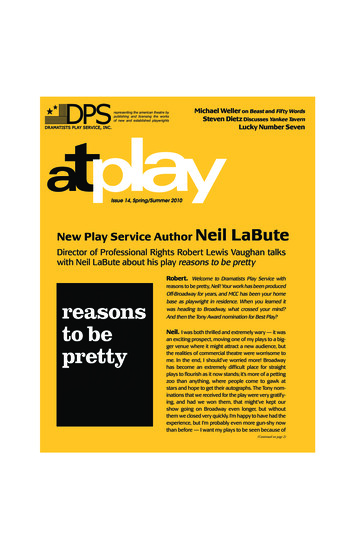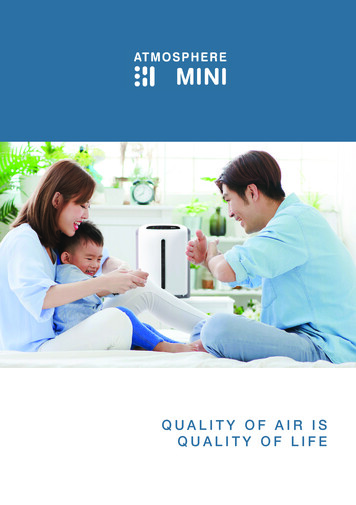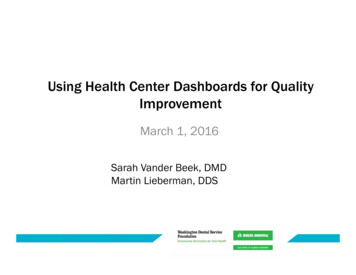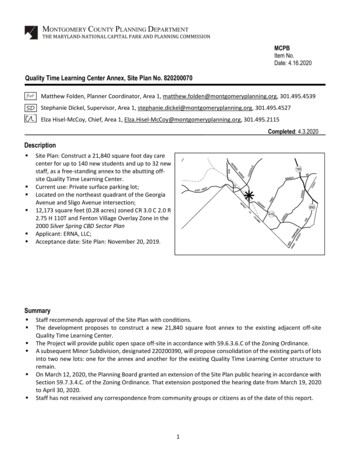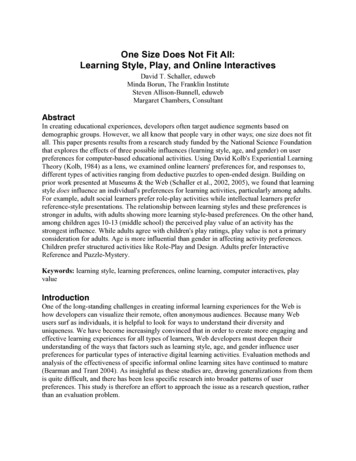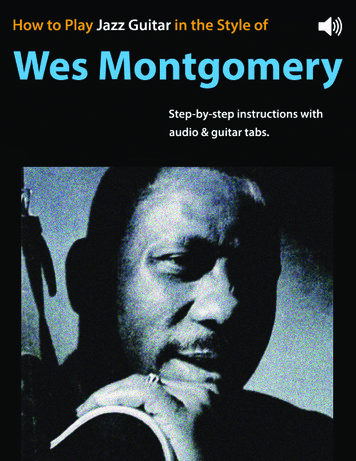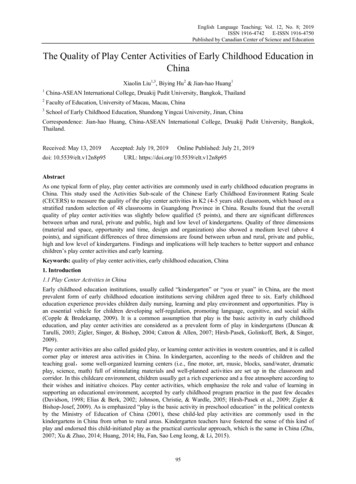
Transcription
English Language Teaching; Vol. 12, No. 8; 2019ISSN 1916-4742E-ISSN 1916-4750Published by Canadian Center of Science and EducationThe Quality of Play Center Activities of Early Childhood Education inChinaXiaolin Liu1,3, Biying Hu2 & Jian-hao Huang11China-ASEAN International College, Druakij Pudit University, Bangkok, Thailand2Faculty of Education, University of Macau, Macau, China3School of Early Childhood Education, Shandong Yingcai University, Jinan, ChinaCorrespondence: Jian-hao Huang, China-ASEAN International College, Druakij Pudit University, Bangkok,Thailand.Received: May 13, 2019doi: 10.5539/elt.v12n8p95Accepted: July 19, 2019Online Published: July 21, 2019URL: https://doi.org/10.5539/elt.v12n8p95AbstractAs one typical form of play, play center activities are commonly used in early childhood education programs inChina. This study used the Activities Sub-scale of the Chinese Early Childhood Environment Rating Scale(CECERS) to measure the quality of the play center activities in K2 (4-5 years old) classroom, which based on astratified random selection of 48 classrooms in Guangdong Province in China. Results found that the overallquality of play center activities was slightly below qualified (5 points), and there are significant differencesbetween urban and rural, private and public, high and low level of kindergartens. Quality of three dimensions(material and space, opportunity and time, design and organization) also showed a medium level (above 4points), and significant differences of three dimensions are found between urban and rural, private and public,high and low level of kindergartens. Findings and implications will help teachers to better support and enhancechildren’s play center activities and early learning.Keywords: quality of play center activities, early childhood education, China1. Introduction1.1 Play Center Activities in ChinaEarly childhood education institutions, usually called “kindergarten” or “you er yuan” in China, are the mostprevalent form of early childhood education institutions serving children aged three to six. Early childhoodeducation experience provides children daily nursing, learning and play environment and opportunities. Play isan essential vehicle for children developing self-regulation, promoting language, cognitive, and social skills(Copple & Bredekamp, 2009). It is a common assumption that play is the basic activity in early childhoodeducation, and play center activities are considered as a prevalent form of play in kindergartens (Duncan &Tarulli, 2003; Zigler, Singer, & Bishop, 2004; Catron & Allen, 2007; Hirsh-Pasek, Golinkoff, Berk, & Singer,2009).Play center activities are also called guided play, or learning center activities in western countries, and it is calledcorner play or interest area activities in China. In kindergarten, according to the needs of children and theteaching goal,some well-organized learning centers (i.e., fine motor, art, music, blocks, sand/water, dramaticplay, science, math) full of stimulating materials and well-planned activities are set up in the classroom andcorridor. In this childcare environment, children usually get a rich experience and a free atmosphere according totheir wishes and initiative choices. Play center activities, which emphasize the role and value of learning insupporting an educational environment, accepted by early childhood program practice in the past few decades(Davidson, 1998; Elias & Berk, 2002; Johnson, Christie, & Wardle, 2005; Hirsh-Pasek et al., 2009; Zigler &Bishop-Josef, 2009). As is emphasized “play is the basic activity in preschool education” in the political contextsby the Ministry of Education of China (2001), these child-led play activities are commonly used in thekindergartens in China from urban to rural areas. Kindergarten teachers have fostered the sense of this kind ofplay and endorsed this child-initiated play as the practical curricular approach, which is the same in China (Zhu,2007; Xu & Zhao, 2014; Huang, 2014; Hu, Fan, Sao Leng Ieong, & Li, 2015).95
elt.ccsenet.orgEnglish Language TeachingVol. 12, No. 8; 20191.2 Key Components of Play Center ActivitiesAppropriate design and proper setting are the premises of play center activities. As Good and Nedler (1974)revealed, play should provide positive emotional atmosphere, fruitful materials, and equipment, and reducerestrictions on children to help children develop their skills and gain different and meaningful experience freely.What are the critical components of high quality play center activities? The idea of high quality of play whichincludes more extended play periods, lots of realistic props and open materials can be used to better understandplay center activities (Copple & Bredekamp, 2009). Based on the existing literature and practice in kindergartens,this study proposed three key components as foundations of play center activities.1.2.1 Sufficient Space and MaterialsSufficient space and materials are crucial elements in play center activities. They facilitate classroommanagement and support the implementation of curricular goals and objectives (Catron & Allen, 2007).Sufficient space requires room for numbers of children to freely operation, without being restricted by the sizeand crowded conditions (Cryer, Harms, & Riley, 2003). Besides, proper play center environments in theclassroom show clear boundaries between areas with adequate space and avoiding interference between activities.There should be enough pieces of equipment and space accessible to a number of children, and they are alsoshould be a variety of interesting options for chosen (Duncan & Tarulli, 2003). A wide range of materials shouldbe provided, including those familiar, novel, natural, and open materials in order to support exploration in theplay.1.2.2 Adequate Time and Opportunity ProvidedIn general, it is necessary to provide ample space, a variety of materials and activities, and encourage children tomove freely without being limited to a small area (Holt, 2010). However, Chudacoff (2007) found that children sfree play with peers has declined sharply over the past half-century in western countries. Play deprivation hasadverse physical and psychological consequences of children, so researchers advocate that children should begiven adequate time and opportunities of play every day (Panksepp, 2007; Fisher, Hirsh-Pasek, Golinkoff,Singer, & Berk, 2011). Although traditional group-teaching and other daily activities take up most of the time inkindergarten, children should have specific time and opportunities to play freely in play centers according to theschedule. In these play centers, children can freely choose the area, independently operate the material anddetermine the speed and difficulty of materials at the level of children s abilities (Sylva et al., 2007). Teachersshould lead to well-prepared and organized activities to ensure that high-level activities are taken place toprovide the full free time of free play for children.1.2.3 Responsive Interactions From TeachersAll researchers agree on the role of teachers in play center activities. They believe that teachers can improve,enrich, and extend children s play through using effective strategies of suggesting, participating, and redirecting(Schweinhart, 1988; Barnett, 2003; Epstein, 2014; Johnson et al., 2005; Hu, Dieker, Yang Y., & Yang N., 2016;Hu et al., 2017). Effective teacher participation in children s play means sensitive attention to children s interestsand development needs, selective choice of when to get involved, expression of appreciation and respect forchildren s perspectives, and recognition of children s efforts and abilities. On the other hand, if teachers providetoo much control, constraints, or interrupts, it usually damages the play. The teacher’s role is responsible forproviding children with a variety of activity materials, implementation, and positive guidance.1.3 Current Research of Play Center Activities in ChinaAt present, relevant researches in China mainly focus on the description of the current situation in kindergartens.The descriptive research on play center activities in China mainly focuses on time, setting, teachers guidance,and other aspects. It was shown that existing problems of play center activities including lack of time for freeplay center activities; a variety of materials but with incomplete autonomy of children. The role of teachers isambiguous and aimless, mainly to ensure that the activities can be carried out (Han, 2013; Li et al., 2014; Gu,2016; Chen & Li, 2015).In recent years, the research on play center activities has been further deepened, and scientific measurement isconsidered to evaluate the quality of play center activities, such as the Early Childhood Environment RatingScale-Revised (ECERS-R) accepted in many countries (Gol-Guven, 2009). In China, few researchers have triedto measure the quality of early childhood education by ECERS-R. In order to reflect Chinese social and culturalcontexts, Li and Hu (2012) modified CECERS based on a rigorous adaptation of ECERS-R (Li & Hu, 2012).Chen and Li (2015) used CECERS to measure the quality of play center activities in 88 kindergartens inZhejiang Province. The results showed that the overall quality of play center activities in Zhejiang is not high;96
elt.ccsenet.orgEnglish Language TeachingVol. 12, No. 8; 2019play center activities had a significant weak predictive effect on children s development results. Luo (2014) alsoused the CECERS in one city and found that the quality of the play center activities, especially the materials andopportunities offered need to be improved.In summary, studies found that there are some problems with play center activities, and the practice needs to beimproved (Yang, 2011; Yang & Deng, 2012; Xu & Zhao, 2014; Chen & Li, 2015). However, there are fewempirical studies on the quality of play center activities by using effective measurement tools such as CECERSin China (Luo, 2014; Chen & Li, 2015). The purpose of this study is to explore the current situation of playcenter activities in other regions in China by using CECERS, and present the detailed quality of play centeractivities (including space and materials, time and opportunity, design and organization). The results areexpected to let the kindergarten teachers know how to carry out and better support play center activities andearly learning for children.2. Method2.1 ParticipantsThis study took place in Guangdong Province with a population of more than 100 million, which has a moredeveloped economy in China. In 2017, the gross enrollment rate of preschool education in Guangdong reached109.08%, and standardized kindergartens accounted for 74.57%. The number of kindergarten children permillion people ranks first, accounts for 9.6% in China (Guangdong Provincial Department of Education, 2018).The study used a stratified random sampling approach to select participants from three regions selected based onper capita GDP to represent high, middle, and low socioeconomic development of Guangdong. A randomsample of 9-20 kindergartens within each region was selected from a complete list provided by the localeducation department, and one K2 (4-5 years old) classroom was randomly selected in each sample kindergarten,totally 48 classrooms (Table 1).The sample included 16 urban and 32 rural classrooms. 45.8% of the kindergartens are at first-class at theprovincial and municipal level, while 54.2% are at the standardized and unrated level. Classroom size rangedfrom 17 to 56 students (Mean 36, SD 7.32),and classroom child-teacher ratio was 6 to 39.5 (Mean 16, SD 6) (Table 2).Table 1. Descriptive statistics of the kindergarten background informationVariableRegionLocationFunding SourceLevelNPercentage n1633.3Rural3266.7Private3625Public1275First-class at provincial2245.82654.2and municipal levelStandardized and unratedTable 2. Descriptive statistics of the classroom background informationVariableNMSDMinMaxClassroom size4836.007.3216.0056.00Child-teacher ratio4816.216.006.0039.502.2 MeasurementChinese Early Childhood Environment Rating Scale (CECERS; Li & Hu, 2012) is the instrument to measure the97
elt.ccsenet.orgEnglish Language TeachingVol. 12, No. 8; 2019quality of early childhood education in Chinese social and cultural contexts. The CECERS comprises 51 itemsorganized in eight sub-scales, and the sub-scale of Activities includes 9 items: (1) role/drama (3 items), (2)blocks (3 items), (3) fine motor (3 items), (4) language (4 items), (5) mathematics (3 items), (6) nature/science (3items), (7) music/rhythm (3 items), (8) art (3 items), and (9)sand/water (3 items), mainly evaluating thepreparedness and implementation of play center activities. CECERS uses a 9-point scoring system ranging from1 (inadequate) to 3 (least acceptable), 5 (qualified), 7 (good), and 9 (excellent). Each item includes threesub-items of material and space, opportunity and time, design and organization.For the study by using the Activities Scale to measure the quality of play center activities, the Cronbach scoefficient of the whole scale is 0.89. Meanwhile, the coefficients of the six items were all greater than 0.82(between 0.82 and 0.95), and the total explanatory variation of the six dimensions was 84.52%, indicating thatthe scale had good reliability and validity.2.3 Data Collection and AnalysisTwo raters from the research team entered each selected classroom to conduct classroom observation usingCECERS. The raters received scoring skills training before using the CECERS scale. The training consisted ofseveral days of intensive study of the instrument and field rating practice that included independenT-testing andgroup discussions. Each rater was required to achieve consistent results with the trainer, and the consistencyreliability coefficient of raters reached 0.85. Each observation of the classroom lasted about 6 hours (typicallyfour hours in the morning and two hours in the afternoon).Before the formal observation, raters were asked to draw a spatial layout of the entire classroom, indicating thelocations and names of the group teaching areas and each activity area. Secondly, the weekly curriculum plan ofthe observed class was obtained to confirm the time and duration of play center activities in the daily schedule.During the observation, it is faithful to the definition of various indicators and related terms in the scale. Thefocus of observation is the process of activities and interaction. Different observation methods are adopted fordifferent observation items. The sub-item "materials and space" observations were focused on the spatial layoutof each play center and the number of materials in the classroom in the class gap time; “Opportunity and time”observations were conducted according to the weekly curriculum plan, the whole day observation and necessaryinterviews with teachers. “Organization and guidance” observations were focusd on the usage of materials andtoys, and the behavior performance of children and teachers in the play.Descriptive statistics were mainly used to analyze the overall quality and three dimensions quality of play centeractivities in China. Besides, the T-test was used to better show the differences in play center activities betweendifferent regions, funding sources, and levels of kindergartens.3. Results3.1 Overall quality of play center activitiesThe overall quality of play center activities is calculated as the average of each item score. On the scale of 1(inadequate), 3 (minimal), 5 (qualified), 7 (good), 9 (excellent), the overall quality rating for the 48 K2 (4-5years old) classrooms is slightly above minimal. The total average score is 4.28, which is higher than theminimum level of 3 points, but lower than the qualified level of 5 points, indicating that the overall level of playcenter activities is not high. The overall quality of play center activities in some sample kindergartens is judgedfrom inappropriate (1 point) to maximum good level (7 points).According to the Central Limit Theorem, the sample size is greater than or equal to 30, and the sample meantends to be normally distributed, which is suitable for statistical analysis (Wu & Tu, 2006). TheKolmogorov-Smirnov test results show that the sample data conform to the normal distribution (p 0.05). Theindependent sample T-test results show that there are significant differences in the overall quality of play centeractivities between urban and rural, private and public, high and low level of kindergartens, which are manifestedas follows: (1) The overall quality of play center activities in urban kindergartens is higher than that in towns andvillages. (2) The overall quality of play center activities of first-class at provincial and municipal level issignificantly higher than that of standardized and unrated kindergartens. (3) The overall quality of play centeractivities in public is significantly higher than that in private kindergartens (Table 3).3.2 Materials and Space Quality of Play Center ActivitiesMaterials and space of play center activities mainly involve the richness, safety and suitability of materials,space, and equipment for center activities. The total average scores of materials and space observed is less than 5points, reaching between the minimum requirements and qualified level (Table 4). In addition to fine motor98
elt.ccsenet.orgEnglish Language TeachingVol. 12, No. 8; 2019Table 3. Comparison of the overall quality of ECERS 5.561.224.871.59Standardized and unrated3.781.22Private3.971.375.211.52First-class at provincialand municipal levelFundingSource**SDPublic**Note. p 0.05, p 0.01,tCompare**5.27Urban Rural2.68**First class Standardizedand unrated-2.64**Public Private***p 0.001.activities, the lowest score of materials and space in each center is inappropriate for 1 point, indicating thatmaterials and space in some kindergartens are not suitable for children s development requirements. The averagescore of materials and space in fine motor activities is the highest, reaching 5.67 points (Min 3, Max 9)higher than the qualified level, which indicates that all kindergartens attach great importance to the developmentof fine motor for children, and sufficient materials are provided. Secondly, the score of materials and space inblocks, math and language area reach 5 points or nearly 5 points (the qualified level), which indicates that inthese areas there are enough materials supplied for some 3 to 4 children to play at the same time. Unfortunately,the scores of materials and space in the role play and science area are only about 3 points (the minimal level),which indicates that the number of materials provided is minimal and cannot meet the needs of multiplechildren s activities.Table 4. Descriptive statistics of materials and space quality of play center 6MS-Role ne Motor5.671.953.009.00MS-Language 14.542.051.009.00MS-Language Science3.922.101.007.00The independent sample T-test results show that there are significant differences in the materials and spacequality of play center activities between urban and rural, private and public, high and low level of kindergartens(Table 5). (1) The materials and space quality of play center activities in urban kindergartens is higher than thatin towns and villages. (2) The materials and space quality of play center activities in public is significantlyhigher than that in private kindergartens. (3) The materials and space quality of play center activities offirst-class at provincial and municipal level is significantly higher than that of standardized and unratedkindergartens.3.3 Opportunity and Time Quality of Play Center ActivitiesOpportunity and t
Bishop-Josef, 2009). As is emphasized “play is the basic activity in preschool education” in the political contexts by the Ministry of Education of China (2001), these child-led play activities are commonly used in the kindergartens in Chin
